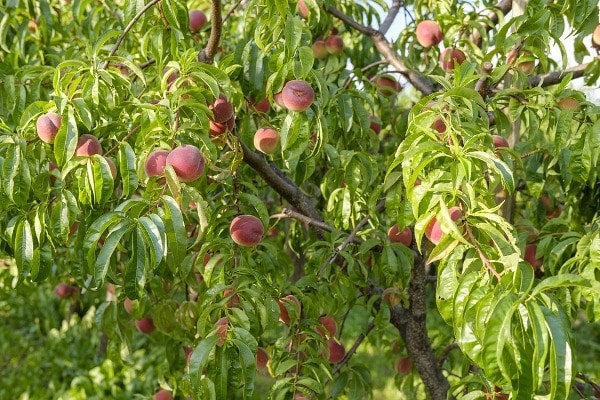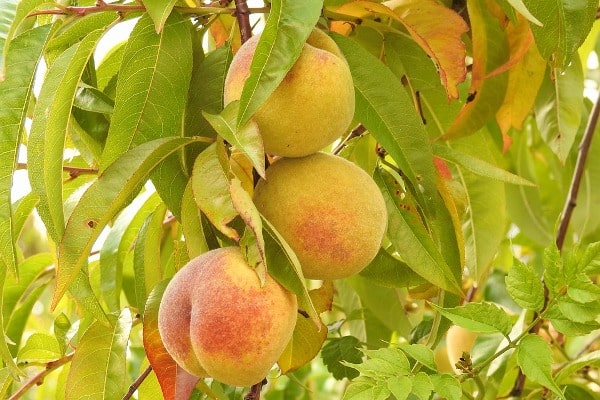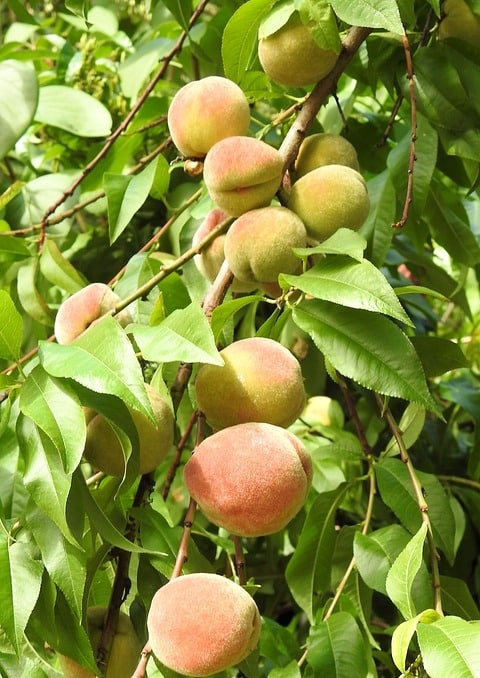Introduction to Peach Fruit Cultivation
The following details are about Peach Fruit Cultivation and Growing Techniques.
The binomial name of the Peach is Prunus persica. The Peach tree belongs to the Rosaceae family. The genus of the Peach originated from the Prunus. The name Persia is a place where the tree was first found in the Europe. This tree is a deciduous tree. It is native to the Northwest China between the Tarim Basin and the north slopes of the Kunlun Mountains. The other name for the Peach is Nectarine.
The other fruits that belong to the same family are Plum, Almond, Apricot and Cherry. These Peaches are grown in the region of North – western Hills states like Jammu and Kashmir, Himachal Pradesh, and Uttar Pradesh. These are also grown in North – Eastern hill states like Sikkim, Manipur, Arunachal Pradesh, Nagaland and Meghalaya. The Peaches are also known as Persian apples.
Characteristics of Peach:
- Plant of the Peach: The upright root growth of the some cultivars differs as they show moderate vegetative growth, but the other cultivars have vigorous growth and also good spreading. The plant can be trained for trellising the fence or the wall. The plants that have upright growth should be trained to grow at 45˚degrees angle horizontally. The tree reaches up to a height of 4 – 10 m and attains a diameter of 6 inches.
- The roots of the Peach plant: In general the Peaches are propagated through seeds. The rootstock can also be sometimes used for Peach Fruit The depth of the rootstock of the Peaches can be in between 300 – 600 mm. The depth also depends on the soil type.
- The Leaves of the Peach: The leaves of this plant are broad and rounded at the base. They are tapered towards the tips with sharp or wide tips; they have short petioles, which are finely scalloped wavy edges. The length of the leaves is 7 – 16 cm, they are 2 -3 cm wide.
- The Flowers of the Peach: The flowers bloom in early spring season, they are white in colour, with long pedicle stalks. They bloom predominantly in the shape of an umbrella and contain 2 – 3 flowers. The diameter of the flower is 2.5 – 3 cm with five petals. The inner part is pink in colour.
- The Fruits of the Peach: Peach fruit has yellow or white flesh in it; the aroma of the fruit is very delicate and the skin of this fruit is either velvety or smooth. The skin, texture and colour of the fruit differ for each variety of the fruit. These are generally round in shape.
- The Seed/Nut/Pod of Peach: Peach fruit contains a single seed in it, which is reddish – brown in colour, oval in shape and it is 1.3 – 2 cm long.

Properties of Peach:
Nutrient properties that are present in Peach are:
- Fat: 0.25 g
- Carbohydrates: 9.54 g
- Energy: 39 kcal
- Protein: 0.91 g
- The vitamins that are present in Peach are Vitamin C, Vitamin E, Vitamin K
- The minerals that are present in Peach are Calcium, Iron, Zinc, Phosphorus, Potassium, Magnesium, Manganese and Sodium.
Cultivars / Varieties of Peach:
These are the popular varieties of Peaches:
Elberta:
- These Peaches are large in size.
- They are golden red in colour.
- The flesh of this variety is yellow in colour.
- The fruit tastes slightly bitter.
- They are harvested in the middle of the season.
Donut:
- This is a freestone type of Peach.
- This variety is sunken in the centre like a doughnut.
- The size of this variety is medium.
- The skin of this variety is white with red streaks on it.
- These are harvested very early.
- They are moderately sweet in taste.
Madison:
- This variety of Peach is medium in size.
- The skin of the fruit is orange in colour.
- The flesh of this fruit is reddish orange in colour.
- The texture of the fruit is fine and flesh is firm.
- These are also a freestone variety of Peach fruit.
- They are rich in flavour.
Halloween:
- This peach variety is large in size.
- The skin of the fruit is yellow with red hints.
- Flesh of the fruit is firm.
- They are freestone variety.
- The flesh is yellow in colour.
- These are harvested late.
These are some other common varieties of Peaches: Desert Gold, India blood cling, Frost, Halford, Empress, Gold dust, Baby Crawford.
Soil and Climate requirements for Peach Fruit Cultivation:

Peach plants can grow practically in deep soil with well draining properties or sandy loam with good percentage of organic matter. The pH of the soil should be around 5.8 – 6.8. These Peach trees can’t tolerate water logging conditions. The acidic or alkaline soils are not suitable for Peach Fruit Cultivation.
These peaches can be cultivated in hilly areas. These can be grown in proper condition in plain land areas too. The temperature, which is ideal for Peach Fruit Cultivation is 25˚C – 30˚C. The rainfall, which is sufficient for the peach plants, is 200 – 300 mm annually. The peach trees need minimum chilling hours.
Land preparation and Planting for Peach Fruit Cultivation:
All the unwanted materials like weeds, pebbles and roots of old crop should be removed or destroyed from the land. The land should be ploughed several times so as to attain fine tilth and smooth texture. After ploughing the soil should be mixed with well decomposed farmyard manure. The seed beds should be prepared for planting the seeds. The drainage should be made in the field. The excess water can be drained out of the land through the drainage channels.
When the buds, grafted plants or seedling develop properly, they should be transplanted into the main field. Proper seed sowing equipment should be used for sowing the seeds. The seed should be sown at a depth of 5 cm in the soil. The dimension of the pit should be 0.75 cm x 0.75 cm x 0.75 cm in the main field. After planting them in the pits light irrigation should be given.
The seedling, buds or grafter plants should be transplanted in the month of December – January. The average spacing between the plants should be 6.5 cm x 6.5 cm.
Propagation method for Peach Fruit Cultivation:
The propagation should be done through grafting or by seeds. For grafting method one year old rootstock should be selected. The seed, which are used for the propagation should be healthy and diseases free. Budding is also one of the methods used for propagating the peach plants.
Manure and Fertilization method in Peach Fruit Cultivation:
At the time of land preparation, well decomposed farmyard manure is applied to the land. The macronutrients should be given to the land in spilt doses. After the soil test the fertilizers like nitrogen, potassium and phosphorus should be applied to the land. Fertilizers should not be applied in excess. After fertilization, light irrigation should be given.
Irrigation methods in Peach Fruit Cultivation:
At the time of planting first irrigation should be given. When the tree starts flowering and fruit setting, then the irrigation is essential for the plant. During rainy season irrigation is reduced. The excess water due to rainfall should be drained out of the land. For saving the water drip irrigation is much preferred. During dry and humid conditions, regular irrigation should be given.
Flowering and Pollination in Peach Fruit Cultivation:
The tree blooms just before 3- 5 months of fruiting. The fleshly bloomed male flower should be located on a different variety of the Peach tree. The male flower should be plucked from the tree and the petal of the flower should be pinched. These pinched flowers should be sprinkled over the female flower of the tree. The male flower’s stamen should be rubbed on the female flower’s stigma for pollination to occur. This is a manual pollination process.
Intercultural methods in Peach Fruit Cultivation:

Weeding: Manual weeding should be done after the seeds are planted in the main field. The weeds can be controlled by removing them manually or by spraying effective weedicides to control the weeds in the commercial cropping area.
Pruning: The unwanted woody parts of the plant should be removed like branches, branch tips, shoot buds or root.
Training: The plant from the initial Growing stage should be trained to trellis the wall or fencing.
Mulching: For controlling the weeds we can use the organic or inorganic mulches on the soil surface. These will help the soil in conserving the moisture. These are specially done for the plants that are planted in a coarse soil, on ridges or on sandy soil.
Fruit thinning: By thinning of the fruits the size and quality of the remaining fruits can be improved. They should be thinned in early summer and the process should be completed by mid – July.
Intercropping: The Peach crop can be intercropped with chillies, ginger, lentils, French bean, rice bean, urad dal, green peas, soybean and other vegetable crops.
Pest and Diseases control measures in Peach Fruit Cultivation:
The most common pest and diseases that are affected to the Peach crop are:
- Beetles: These beetles can be controlled by spraying hexavin.
- Brown rot: The intensity of brown rot can be controlled by spraying captan.
- Bacterial canker: By spraying copper, the intensity of the bacterial canker.
- Flat – headed borer: By seed treatment with durmet, the flat – headed borer can be controlled.
- Leaf curl aphid: For controlling the leaf – curl aphid, rogor spray should be used.
- Shot hole: We should spray thiram or captan to control the shot hole.
- Black aphid: For controlling black aphids we should spray Malathion.
Harvesting techniques in Peach Fruit Cultivation:
It takes 2 – 3 years for the plants to produce mature fruits after planting. They should be harvested when they attain good colour, firmness and ripening. The fruit can be harvested manually. The fruits that are ripe should be picked from the tree.
Post harvesting techniques in Peach Fruit Cultivation:
Cleaning: The Peaches should be washed and cleaned after they are harvested so as to remove the fertilizers.
Storage: The unripe Peaches should be stored in paper bags, when they are ripened they can be stored at room temperature. The ripe fruit should be used within 1-3 days.
Sorting: The Peaches should be sorted as per the shape and size
Grading: They should be graded as per their quality and colour.
Packing: They should be packed in crates and carton boxes in each box; they should be packed as per there colour and size. Each box contains 6 – 7 kg of fruits.
Yield of Peaches:
The yield completely depends on the Peach variety; the average yield of the Peach is about 20 – 30 kg per tree in a year.
Read: Passion Fruit Cultivation.

Thank you so much for eye opening article.its so inspiring.
Thank you so much for this valuable piece of information.